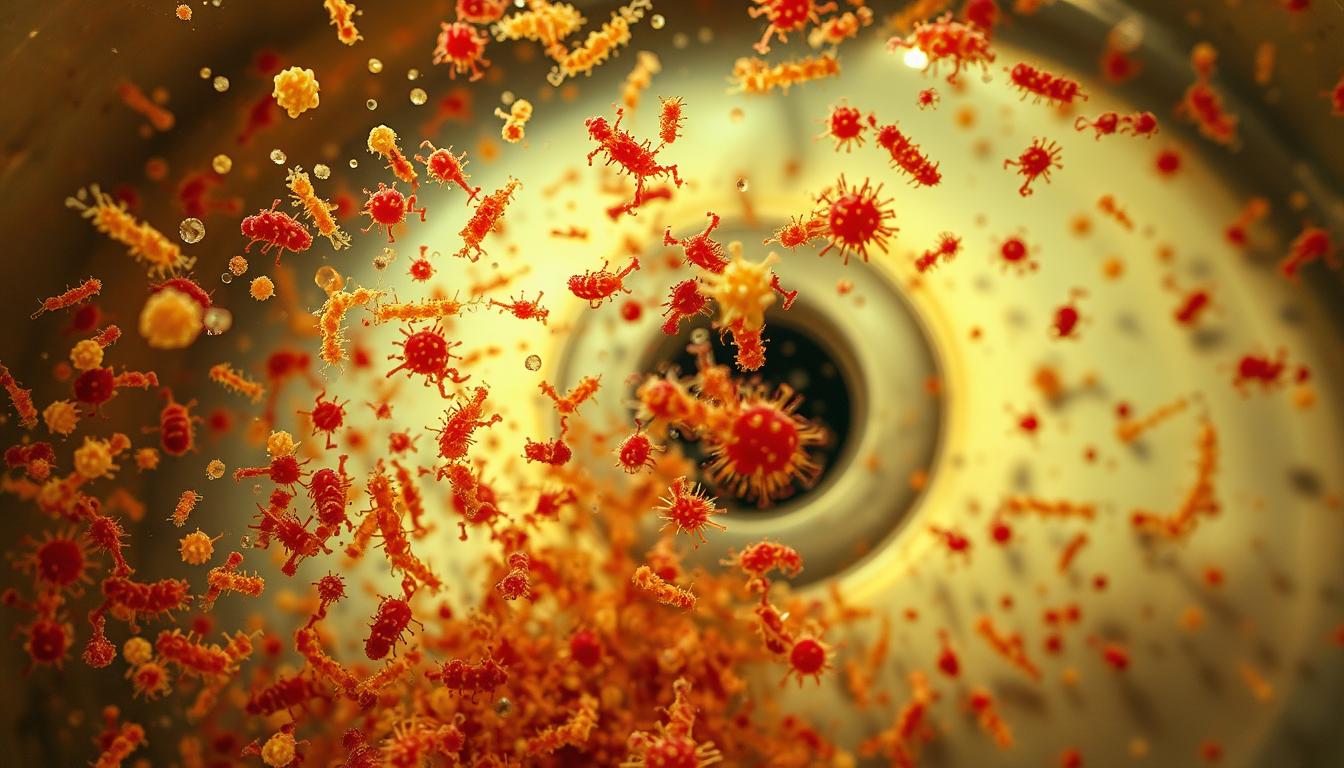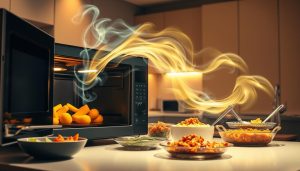Did you know your kitchen sink likely contains 75% more harmful bacteria than your bathroom trash can? Research from NSF International shows nearly half of all sinks tested positive for coliform bacteria – including strains linked to food poisoning. This shocking statistic reveals a truth most homeowners overlook: the heart of your kitchen doubles as a microbial hotspot.
Microbiologists like Dr. Charles Gerba found dangerous organisms thriving in this space. Salmonella and E. coli cling to crevices, while listeria hides in leftover food particles. These pathogens don’t just linger – they multiply rapidly in warm, damp environments. Every chopped vegetable or rinsed plate becomes a potential contamination risk.
What makes this area particularly risky? Frequent contact with raw meats and produce creates a perfect storm. Moisture from dishwashing accelerates bacterial growth, turning stainless steel into an invisible threat. Even clean-looking surfaces often harbor colonies ready to spread to hands, utensils, and meals.
Key Takeaways
- Kitchen sinks contain more bacteria than most bathroom surfaces
- Coliform bacteria appear in 45% of sinks according to scientific studies
- Moist environments and food debris fuel microbial growth
- Common pathogens include salmonella, E. coli, and listeria
- Proper cleaning methods significantly reduce contamination risks
Introduction to Kitchen Sink Germs
Research reveals your cooking area’s basin harbors more microbes than most bathroom fixtures. NSF studies show 45% of sinks test positive for coliform bacteria – nearly double the rate found on toothbrush holders. College housing inspections found drains ranked third for contamination, hosting mold colonies and E. coli strains.

Food prep routines turn this space into a microbial hub. Raw meat juices and vegetable scraps create a buffet for pathogens. Warm water from dishwashing maintains ideal breeding temperatures, letting colonies double every 20 minutes.
Many assume bathrooms pose greater risks, but faucet handles there show 9% contamination rates compared to sinks’ 45%. This disparity stems from frequent exposure to organic matter. Sponges and scrub brushes often transfer microbes back to surfaces during cleaning attempts.
Effective maintenance requires understanding three factors: moisture control, debris removal, and disinfectant contact time. Daily wipe-downs prevent biofilm formation, while weekly deep cleaning tackles hidden crevices. Prioritize these habits to transform your basin from a hazard zone into a sanitary workspace.
Understanding the Germs That Live in Your Kitchen Sink
Your food prep zone doubles as a microbial breeding ground. A 2023 Department of Agriculture study tracked a traceable E. coli strain through breakfast preparation. Researchers found 72% higher contamination levels in sinks compared to countertops after handling raw sausages.

Drains prove particularly problematic. NSF research reveals these areas contain:
- Yeast colonies thriving in moist environments
- Mold spores clinging to pipe walls
- E. coli populations 200x higher than faucet handles
Food particles trapped in crevices create self-sustaining contamination cycles. “Sinks become bacterial incubators when organic matter accumulates,” notes a Department of Agriculture report. Salmonella survives 32 hours on stainless steel – enough time to contaminate three subsequent meals.
“Our data shows sinks consistently outrank cutting boards and countertops as primary cross-contamination sources.”
Microbial communities exhibit complex behaviors. Aerobic bacteria dominate surface areas while anaerobic strains flourish in drain pipes. This dual ecosystem resists standard cleaning methods, requiring targeted approaches.
Effective management involves:
- Immediate debris removal after food prep
- Daily disinfectant sprays on high-touch zones
- Weekly deep cleaning of drain assemblies
Understanding these dynamics helps break contamination chains before pathogens reach your plate.
Common Bacteria and Cross-Contamination Risks
The space where you rinse produce and clean dishes secretly hosts dangerous microbial exchanges daily. Three pathogens dominate this hidden ecosystem, each capable of triggering severe health issues when transferred to meals or cooking tools.

Foodborne Illnesses Explained
Salmonella, E. coli, and Listeria form the primary bacterial threats in food prep areas. These organisms thrive where organic matter accumulates, multiplying rapidly in damp environments. Symptoms escalate from mild nausea to kidney failure depending on exposure levels.
| Bacterium | Common Sources | Health Impact |
|---|---|---|
| Salmonella | Raw poultry, eggs | Fever, diarrhea (48hrs) |
| E. coli | Undercooked beef | Severe cramps, vomiting |
| Listeria | Deli meats, soft cheeses | Neurological complications |
How Cross Contamination Occurs
Pathogens spread through indirect contact when cleaning routines fail. A Department of Agriculture study found 68% of dish towels tested positive for E. coli after wiping contaminated basins. This transfer chain often looks like:
- Raw meat juices → sink surface → clean vegetables
- Food debris in drain → hands → cooking utensils
- Contaminated sponges → countertops → prepared meals
“Sink-to-food transmission accounts for 33% of preventable foodborne cases annually.”
Preventive measures start with immediate debris removal and thorough handwashing. Always sanitize cutting boards after contact with raw proteins, and never rinse poultry – it sprays bacteria up to 3 feet.
Effective Cleaning Techniques for a Hygienic Sink
Many assume sparkling surfaces mean safety, but true sanitation requires strategic methods. Start by flushing drains with hot water to dislodge food particles before they harden. This prepares surfaces for deeper treatment without spreading contaminants.
Step-by-Step Cleaning Guide
For daily maintenance, mix dish soap with warm water to wipe down basins after washing dishes. Weekly deep cleaning follows three phases:
- Pour ½ cup baking soda into drains followed by 1 cup white vinegar
- Let foam work for 2 hours to dissolve biofilms
- Rinse with boiling water to flush debris
After handling raw meat, immediately scrub surfaces with soapy water. Use separate cloths for cutting boards and utensils to prevent cross-contamination.
Essential Cleaning Tools and Products
Microfiber cloths outperform sponges by trapping 99% of bacteria during wipe-downs. For stubborn stains:
- Apply undiluted white vinegar for 30 minutes
- Scrub gently with baking soda paste
- Rinse thoroughly with hot water
Professional cleaners recommend monthly drain treatments with enzymatic products. These break down organic matter without damaging pipes. Always wash hands after cleaning and store tools in dry areas to prevent bacterial regrowth.
Natural Solutions for Eliminating Kitchen Sink Bacteria
Transform your cleaning routine with pantry staples that tackle hidden threats. Simple ingredients like white vinegar and baking soda outperform harsh chemicals while keeping food prep areas safe. For those seeking creative alternatives, our guide to lemon-based solutions offers additional eco-friendly strategies.
White Vinegar and Baking Soda Method
Combine ½ cup baking soda with 1 cup white vinegar for a fizzy reaction that scrubs drain surfaces. The foam lifts biofilms where pathogens hide. Let it work for two hours before flushing with boiling water to eliminate residue.
Using Hot and Soapy Water Effectively
Daily rinses with hot water (140°F+) reduce bacterial populations by 90%. Add dish soap to break down grease trapping food particles. Alternate with cold water pours to solidify oils in drains for easier removal.
These methods create multiple defense layers. Weekly vinegar treatments disrupt microbial growth cycles, while soapy water maintains daily hygiene. Always dry surfaces thoroughly – moisture control remains critical for lasting results.



